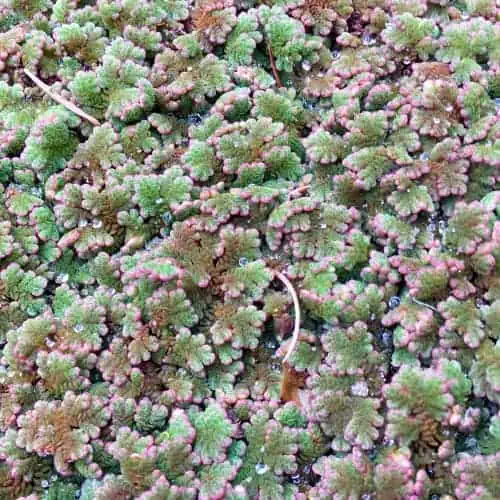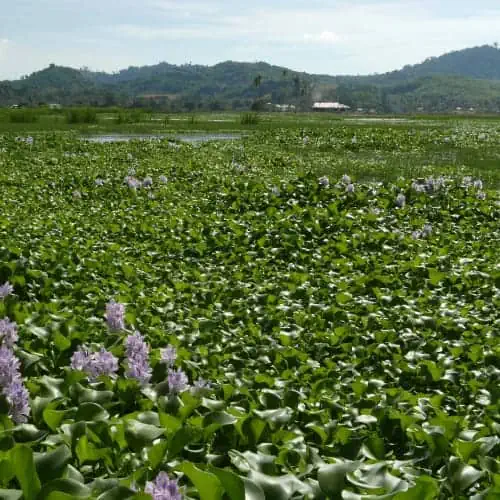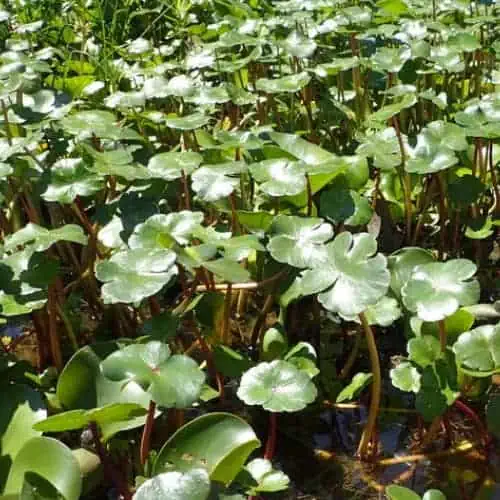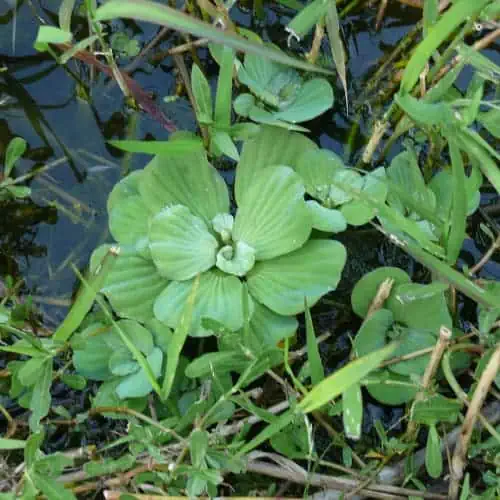
Some aquatic plants have a knack for spreading all throughout their freshwater environments. In a pond, freshwater can be described as a continuous or homogeneous fluid that contains dissolved nutrients and minerals. Thus, plant fragments and seeds can be dispersed into just about any part of a pond system. If they come in contact with the appropriate resources for settlement and growth, they may quickly form colonies. While some plants are beneficial, others tend to become overabundant and troublesome.
Aquatic plants are seldom limited to the boundaries of the water features in which they are found. Like terrestrial plants, which have evolved to rely on an assortment of vectors for dispersal, the fragments and seeds of pond weeds can cling to animals, boats, rubber boots, and just about any type of solid surface. When these come into contact with other water systems, the reproductive plant parts are then introduced into new, potentially colonizable environments.
Invasive pond weeds tend to have a tolerance for a wide range of conditions. They come in 3 types – submerged, free-floating, and emergent plants. They possess adaptations for growth and survival wherever there is fresh water. Their spread is emphasized particularly during warm months and whenever nutrient levels peak. As primary producers that rely on sunlight to grow, they consider light-exposed pond surfaces prime real estate. Once they colonize these areas, their presence may induce light deprivation and anoxia.
Invasive aquatic plants tend to grow faster than their native counterparts, with which they compete for resources. Although they may look attractive and could potentially be beneficial in limited quantities, it would be prudent to avoid growing them outside of their native range. The cultivation of these species is often regulated by local government organizations.
1) Broadleaf watermilfoil (Myriophyllum heterophyllum)

Often misidentified as other types of aquatic plants, the broadleaf watermilfoil has highly varied characteristics. It is also known as twoleaf milfoil, as the form of its leaves differs based on their position relative to the water’s surface. Submerged leaves are finely dissected and cause the shoot to resemble the form of a raccoon tail, whereas leaves on the emergent bracts tend to be smaller and appear only in summer.
In the photic zones of ponds, broadleaf watermilfoil can produce dense mats. Its shoots may measure up to 10 feet tall (arising from the pond bottom) in well-lit areas. It is able to tolerate a wide range of temperatures, water chemistry parameters, and pH levels. Due to both vegetative and sexual methods of reproduction, this species can rapidly spread and displace slow-growing, native plants. Its fragments can grow by about an inch each week!
In areas with considerably-sized watermilfoil colonies, annual management of the plant’s spread has been necessary. Mechanical removal, benthic barriers, and herbicides are necessary to prevent it from fully overgrowing pond systems. In cases where it does, it significantly reduces biodiversity, prevents light from penetrating through the water column, and hampers recreational activities.
This species is now on the prohibited plant lists of many regions in the US and Europe. Other watermilfoil species to watch out for, as they are also invasive plants, include Eurasian watermilfoil (M. spicatum) and parrot’s feather (M. aquaticum).
2) Fairy fern (Azolla filiculoides)

With its intricate, floating pads of leaflets, the fairy fern can be quite adorable as an ornamental feature of ponds and fountains. Under ideal conditions, however, its colonies can expand to twice their initial spread in less than a week! Unless you can frequently rake the surface of your pond and it is completely biosecure (meaning no wild animals are able to move into or out of the system), this is one tiny plant that you should definitely avoid. In just a few months, the fronds of A. filiculoides are capable of masking the entire surface of a small lake!
This small, free-floating fern can reproduce by two means. Vegetative reproduction occurs throughout the year, as fragments break off of the main plant and produce their own new roots and leaves. These can float off to other parts of the pond, creating mats that shade out underlying vegetation. As it is a type of fern, it is also capable of producing spores. These support widespread dispersal as they can get trapped onto the feathers of waterfowl or the fur of wild mammals. Minor flooding events may also carry these into public waterways.
A. filiculoides was once intentionally introduced into many water systems as it can supposedly fix high rates of nitrogen, improve the growth of aquatic crops, and be utilized as “green manure”. Unfortunately, infestations can lead to the mass die-off of submerged plants and fish as water oxygenation rates and light exposure are reduced. Moreover, escaped colonies can block canals, leading to the increased risk of flooding or a compromised water supply. As a noxious weed, it is now prohibited in the US and in some parts of Africa.
3) Common water hyacinth (Eichhornia crassipes)

It’s all too easy to fall in love with the delicate, lavender blooms of this aquatic species. They almost make up for its invasive potential! Water hyacinth is a tropical perennial hydrophyte that can stand as tall as a meter above the water’s surface. Its rich green leaves are borne on stems that float due to buoyant nodules. Its roots are featherlike and remain freely hanging, from the base of the stems, in the water column.
This species grows so rapidly that it can increase by up to several meters in height after just a few days of growth. Its colonies can expand exponentially to multiple times their initial size in as little as a few months. This is due to the presence of submerged stolons from which daughter plants may arise. As though these weren’t enough to secure the survival of colonies, the water hyacinth produces seeds with viability that lasts for dozens of years.
Due to the prolific nature of this species, it may be cultivated and harvested in large amounts for use as a source of fiber-rich materials. Its tolerance for heavy metals gives it potential as a bio-cleaning agent for industrial pollutants in wastewater. Unfortunately, its growth rate is often too unmanageable. Once it completely covers the surface of a pond, it can compete with native plants and fish by depriving them of oxygen. In the worst case, colonized ponds become breeding grounds of mosquitoes and decaying organisms. This pest plant is now prohibited in several regions of North America, Europe, and Australia.
4) Floating pennywort (Hydrocotyle ranunculoides)

Due to this species’ popularity as an ornamental pond plant, it has escaped into many public waterways and has developed invasive colonies in natural freshwater bodies. This wetland species is an aggressive spreader in shallow, stagnant, or slow-moving water. Interestingly, its native populations are becoming increasingly endangered in the US, whereas its alien populations in Europe and Australia are highly problematic.
Floating pennywort is distinguished by its multi-lobed, glabrous, and crenated leaves. These arise on horizontally-spreading stems which can remain afloat on the water’s surface or creep onto the edges of water features. In summer or early fall, this plant produces small umbels with about 5 – 13 flowers each. Ranging in color from green to white, the blooms are star-shaped. They may attract insects as pollinators.
Optimal conditions, such as lengthier daylight hours and warmer temperatures in summer, may cause the leaves of floating pennywort to grow larger and stand further above the water’s surface. Capable of forming dense mats that can expand at an almost unbelievable speed (around 20 cm/day), this species can be dispersed via fragmentation. Damage of the shoots tends to facilitate dispersal as they can quickly regenerate. As a result, H. ranunculoides is now illegal to import, cultivate, and sell in the EU.
5) Water lettuce (Pistia stratiotes)

One of the most common aquatic plants known to man, P. stratiotes has made its way into virtually every wetland region in the tropical to subtropical regions of the world. Also known as water cabbage, shellflower, and Nile cabbage, this perennial species is known for its thick, almost succulent leaves, which arise in a rosette formation. Densely covered in fine and short hairs, the light green leaves appear highly textured due to their parallel veins and lightly crenated margins.
Water lettuce usually spreads by asexual means, via the expansion of a colony through stolon propagation. In slow-moving water bodies with regular nutrient input due to stormwater run-off or sewage and fertilizer contamination, water lettuce may exhibit weed-like expansion. This species also tends to accumulate in manmade water systems, such as ditches, canals, reservoirs, and dams. Introduction to new areas through man-made vectors, such as boats and fishing gear, is also rampant.
Once water lettuce colonies have severely overgrown a pond or lake, the underlying water tends to become a site for pathogen growth. The colonies also facilitate the spread of dangerous diseases, such as filariasis and malaria, by creating pockets of still water for mosquitoes. Their floating mats block out light and oxygen while impeding recreational activities. In many areas, chemical, biological, and physical controls have been employed to reduce infestation rates.
6) New Zealand pigmyweed (Crassula helmsii)

Also known as swamp stonecrop due to its stiff leaves and shoots, the New Zealand pigmyweed is considered a succulent macrophyte and is classified under the Crassulaceae family. Its stems and foliage can tolerate being fully exposed, semi-submerged, or fully submerged. It is thus popularly used as an aquarium plant or an emergent species in ornamental ponds. The spread of its colonies needs to be managed, however, as their mats can become extremely dense.
When stands along the water’s surface or pond edges block out sunlight, they reduce water aeration rates and compete with underlying species. They can completely stifle the growth of native plants, thereby reducing biodiversity and altering water parameters. The pigmyweed is known for being quite challenging and costly to control, especially as small fragments can develop into large colonies.
The aquascaping industry has been instrumental in facilitating the widespread distribution of this invasive plant. As it can be propagated so easily, it is a common favorite. Unfortunately, fragments of its shoots can even “contaminate” other aquarium species, making its dispersal hard to trace and often accidental. It is now declared a noxious weed and is prohibited in several countries.
7) Curly-leaved waterweed (Lagarosiphon major)

Often used as an aquarium plant due to its attractive features, the curly-leaved waterweed has made its way into many regions of the world. It is also known as African elodea and oxygen weed. In contrast to what the latter name suggests, this species can significantly reduce, instead of increase, dissolved oxygen levels when it is present in dense quantities. Its shoots can infest the entire volume of small lakes, outcompeting all native, submerged aquatic plants.
Curly-leaved waterweed produces adventitious roots that can colonize the substrate through rhizomatous spread. The phenomenal stems grow up to 20 feet long in clear water as they make their way to the surface. Its terminal floral stalk is emergent and produces remarkably small blooms. These develop into capsule-like fruits that contain about nine tiny seeds each.
The combination of both vegetative propagation and self-seeding ensures that native populations are sustained. Interestingly, no male plants of this dioecious species are present outside of southern Africa. This means that colonies found elsewhere have spread exclusively via the vegetative dispersal of female plants. This goes to show how effective physical vectors, including torrential storms, are at spreading fragments of invasive aquatic weeds!
8) Hydrilla (Hydrilla verticillata)

This popular aquarium plant is now considered an invasive species in several continents, including the Americas, Europe, and Australia. Often unintentionally introduced into natural bodies of water, it is known for contaminating shipments with other types of aquatic herbs. Once the fragments are exposed to favorable growth conditions and an ideal substratum, they quickly produce new vegetative structures that can multiply through fragmentation as well.
Hydrilla is a master of survival as it has structures that allow it to “hibernate” when conditions are unfavorable (e.g. during winter). These specialized structures, called turions, store essential nutrients. These may eventually become detached from the main plant and can also develop on free-floating fragments, remaining viable for up to 4 years! Apart from turion production, hydrilla is so effective at colonizing freshwater bodies due to its tolerance for low light conditions, moderate salinity (up to 7 ppm), and pollutants.
Apart from fragmentation, hydrilla colonies can spread via their underground tubers and stolons. The shoots are able to expand horizontally by branching out at their nodes. Small colonies first become invasive in deeper areas of the pond, where other aquatic plants would struggle to grow. The colonies then begin to spread aggressively into shallower, bright areas where they compete with other living organisms for light.
A colony can eventually become dense enough to fill the entire volume of a freshwater body. Its spread negatively impacts pond ecosystems by completely blocking out sunlight, reducing oxygen levels, impeding the movement of water, increasing pH levels, and altering species diversity. As a result, plankton, invertebrates, and fish can no longer move through the water and obtain the necessary nutrients for survival. Avoid growing this species and opt for native, slow-growing alternatives instead.

